Customer Relationship Management (CRM) systems have emerged as invaluable business tools. The growing competition pushes small businesses and enterprises to manage and analyze customer interactions and data throughout the customer lifecycle. This results in enhanced customer service, retention, and amplified sales numbers.
Grand View Research valued the global CRM market at $58.04 billion in 2020, and the same is projected to expand at a compound annual growth rate (CAGR) of 14.2% from 2021 to 2028. Such substantial growth signifies the growing reliance of businesses on CRM systems to streamline their customer engagement strategies and foster stronger relationships.
There are different types of CRM — operational, analytical, and collaborative — each designed to drive specific business goals. The choice of a specific CRM type often depends on a business’s unique needs and objectives. Here, we will consider three major types of CRM software along with examples and a list of businesses they are best suited for.
Content:
Operational CRM
Operational CRM systems and software solutions help streamline sales, marketing, and customer service processes. It ultimately drives operational efficiency and revenue, increases customer satisfaction, and enhances customer retention.
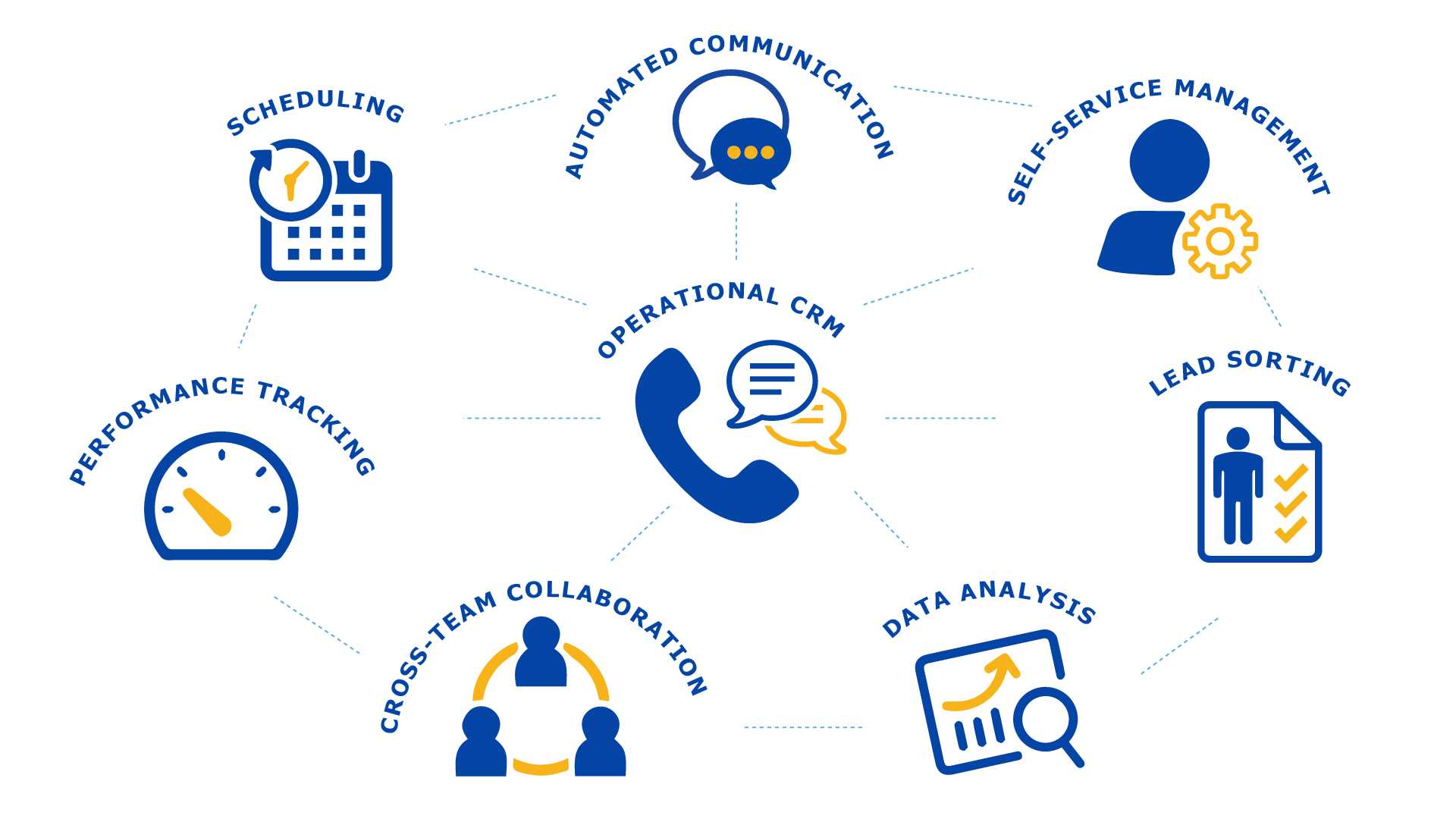
Since it can automate repetitive tasks, businesses save time and resources in decision-making by getting valuable insights into customer behavior and trends. At its core, operational CRM enables seamless, efficient processes that enhance customer satisfaction and increase profitability.
Here are the key aspects of operational CRM:
- Sales force automation. This type of operational CRM automates the business tasks of the sales team, including order processing, contact management, information sharing, inventory monitoring, sales forecast analysis, and employee performance evaluation.
- Marketing automation. It leverages CRM to effectively market on multiple channels online and automate repetitive tasks. For instance, email automation tools can push alerts to keep people up-to-date on upcoming events, leverage chatbots to offer around-the-clock support, and run drip email campaigns to promote special offers. It can effectively streamline and optimize marketing efforts while playing an essential role in nurturing leads, converting them into customers, and maintaining customer relationships.
- Customer service automation. Customer service automation enhances the processes necessary for customer experiences to increase operational efficiency. It generates automated responses to common queries, ticketing systems, and chatbots for a faster, error-free turnaround.
Operational CRMs are suitable for:
- Businesses looking to streamline everyday operations. Operational CRM can automate many mundane tasks, free up staff time, and help ensure nothing falls through the cracks. Therefore, businesses finding solutions to everyday operations can opt for any of the aforementioned operational CRMs.
- Businesses with sales, marketing, and customer service teams. Any organization’s sales and marketing teams can hugely benefit from the coordination and efficiency of an operational CRM. It ensures that all teams can access the same information and collaborate effectively.
Now that we know what operational CRM is, let’s look at a few examples.
SendPulse
SendPulse is a unified marketing solution that offers free CRM for businesses. CRM automates sales and customer communication, thereby allowing businesses to manage their sales and marketing processes and communication channels in one place. It allows them to store all customer information in the CRM database that can be used to reach customers through email and messengers.
Pricing: The platform offers you a forever free plan and is currently developing paid pricing options for advanced functionality.
Salesforce
Salesforce CRM comes with modules like marketing cloud, service cloud, analytics cloud, app cloud, and sales cloud. Such modules are useful for large sales teams as it allows sales personnel to manage contacts, access sales content, and monitor sales activities from anywhere, on any device.

Pricing: This CRM offers four pricing plans with different features. Salesforce pricing starts at $25 per month, with more expensive plans getting as high as $300 per month.
HubSpot
HubSpot CRM is popular for its integrations across customer data, allowing businesses to track interactions, manage customer data, and improve customer service. The platform offers the whole gamut of marketing integrations, and there are also third-party integrations in terms of software solutions that enable sharing data and functionality.
For instance, sales-driven organizations can choose HubSpot CPQ to create accurate and highly configured quotes. Similarly, different HubSpot integrations include account-based marketing, analytics, data Integrations, content integrations, etc. These aspects can significantly streamline sales.

Pricing: HubSpot offers various plans for small businesses and enterprises. For example, their basic plan with essential sales tools starts at $18/month, while the Professional bundle costs $800/month, and the Enterprise version is available from $3600/month.
Analytical CRM
Analytical CRM collects customer data, analyzes it, and enables teams to make informed business decisions. It thrives on user data to derive valuable insights about customers to improve customer service, marketing, and sales strategies.
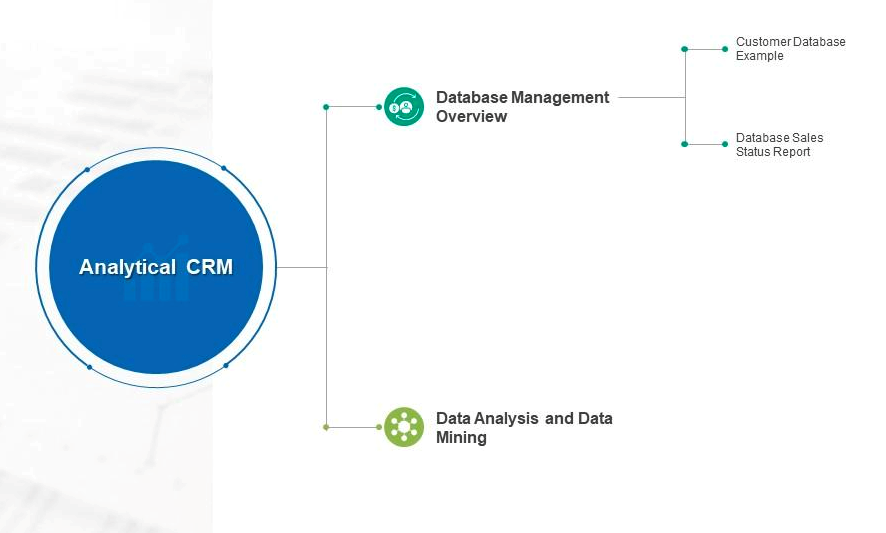
With data at its disposal, this type of CRM helps discover customer action patterns to figure out what strategies work best for closing sales, how to keep your best customers coming back, and what issues customers often have
Here are three major aspects of analytical CRM:
- Data warehousing and integration. Data warehousing refers to collecting, storing, and managing large amounts of data from different sources in a single, centralized location. Integration here refers to combining data from different sources into the data warehouse. This gives businesses a holistic view of their customer data and ensures that it is consistent and easily accessible for analysis.
- Business intelligence. BI uses data collection and analysis to provide actionable insights for business decision-making. It involves tools and techniques that transform raw data into meaningful information. As an analytical CRM, BI can help understand customer behavior, measure campaign effectiveness, and assess customer satisfaction.
- Predictive analytics. Predictive analytics involves statistical techniques and machine learning algorithms to analyze historical data and predict future events or behaviors. In analytical CRM, predictive analytics can help predict future customer behavior, identify opportunities, and anticipate problems or challenges.
Analytical CRMs are right for:
- Businesses aiming to drive data-backed decisions. Analytical CRM is the answer for businesses looking to make decisions based on reliable data and insights rather than intuition. It offers tools and techniques to analyze customer data and derive actionable insights.
- Businesses that need to identify patterns and trends. Analytical CRM is ideal for businesses that need to identify patterns, trends, and relationships in their customer data. Such an approach is useful in predicting future behavior, identifying potential opportunities, and tailoring team efforts (marketing, sales, operations, etc.) to specific customer segments.
Now that we know what analytical CRM is, let us check out a few of its examples.
Pipedrive
Pipedrive is a sales-driven CRM tool that prioritizes deals, predicts revenue, and monitors performance for business growth. It helps manage business leads and deals by keeping track of communications, automating tasks, and providing customizable reports and data fields.
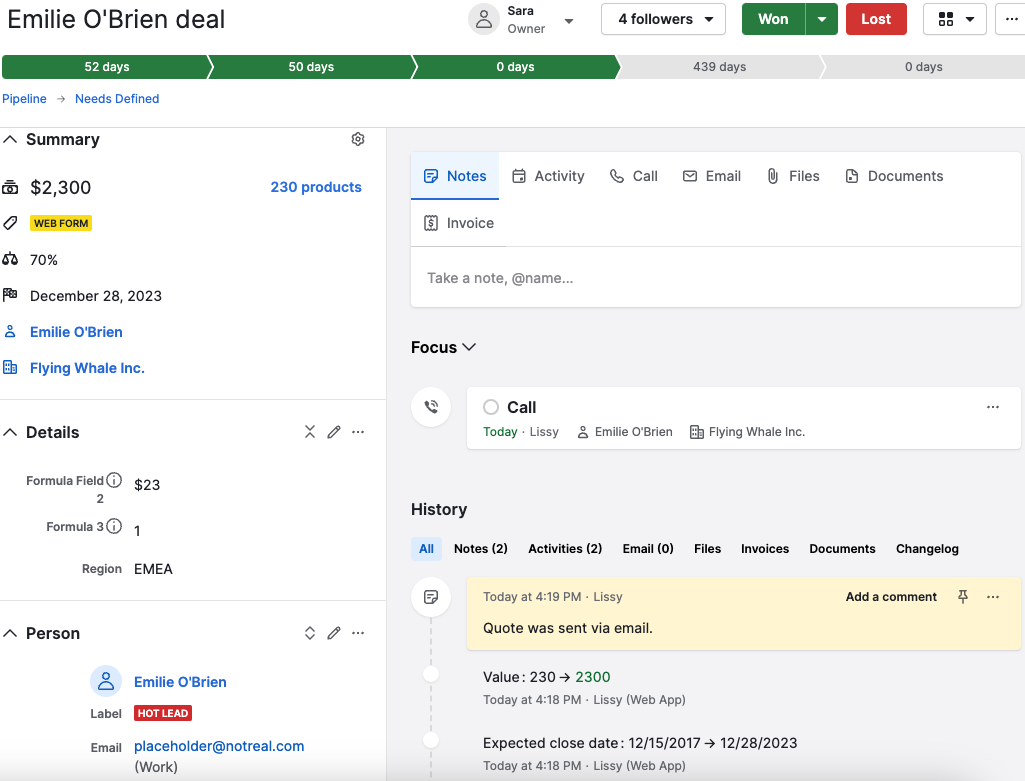
Pricing: There are a range of packages for this software. It starts with the Essential pack for $9.90/month, Advanced for $19.90/month, Professional for $39.90/month, Power for $49.90/month, and the Enterprise one that will cost you $59.90/month.
Pega
This intelligent sales automation tool uses AI to enhance sales performance, predict customer needs, and streamline key sales processes. Pega identifies potential revenue opportunities, provides a comprehensive view of the customer, and offers real-time sales forecasts.

Pricing: Pega offers three different Sales Automation editions from $140/month per user to $250/month per user.
Collaborative CRM
Multiple departments often work in silos and hardly share customer information, which can lead to losing business. Collaborative CRM enables teams to work cohesively to serve customers better.
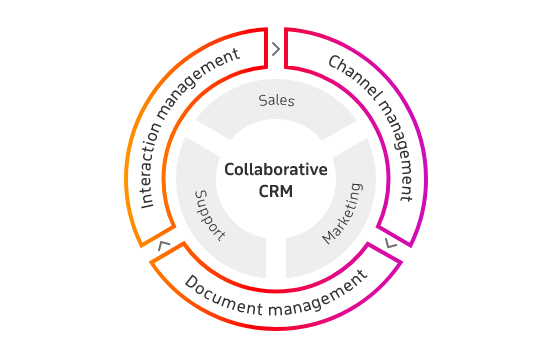
Collaborative CRM emphasizes coordination and collaboration among various departments (sales, marketing, and customer service) to improve customer experience. Customer support has all the information marketing and sales teams provide when engaging with a potential consumer. Next, the contact center operators update data on customer interactions across email or messaging channels.
Each engagement in collaborative CRM is part of a bigger narrative involving the brand and the consumer. Consumers can avoid repeating themselves while interacting with new contacts since departments and channels are integrated.
Here are some of the key aspects of a collaborative CRM:
- Communication management. Communication is key to collaboration; therefore, a collaborative CRM helps manage all communication channels with customers like email, phone, social media, live chat, and others. Ultimately, such a CRM provides a consistent, unified, personalized customer experience across all touchpoints.
- Document and content management. Businesses can leverage collaborative CRM for creating, storing, and sharing documents and other content related to customers. It helps ensure all teams access the same up-to-date information that adds value when dealing with complex customer issues or inquiries.
- Workflow automation. Collaborative CRM can also provide workflow automation to streamline and automate routine tasks and processes. This increases efficiency, reducing errors and allowing staff to focus more on their core responsibilities. In a CRM context, workflow automation is handy in automatically assigning new leads to sales reps or sending automated email responses to common customer inquiries.
Collaborative CRM is suitable for:
- Businesses pivoting to collaboration between departments and partners. If company’s departments have traditionally operated in silos, moving to a collaborative CRM system can help break down those barriers and facilitate more effective cooperation.
- Companies looking to enhance customer experience through joint efforts. If a business seeks to improve its customer experience, a collaborative CRM can help by ensuring all teams have access to the same customer data and insights. This can lead to more coordinated and effective customer interactions.
Since we know what analytical CRM is, let us explore some of its examples.
Slack with CRM integrations
While not a typical CRM, Slack may be integrated with various CRM software to improve real-time collaboration on customer-related activities and data. It is a hub where teams can meet to discuss customer contacts, exchange files, and organize work.

Pricing: Slack offers a free option and several paid plans starting from $7.25/month.
Freshsales
Freshsales is a sales-focused customer relationship management platform that improves teamwork by providing a bird’s-eye view of all active transactions. It enables reviewing several pipelines in the timeline, funnel, classic, or condensed view, which help monitor the current standing of all transactions across all representatives.
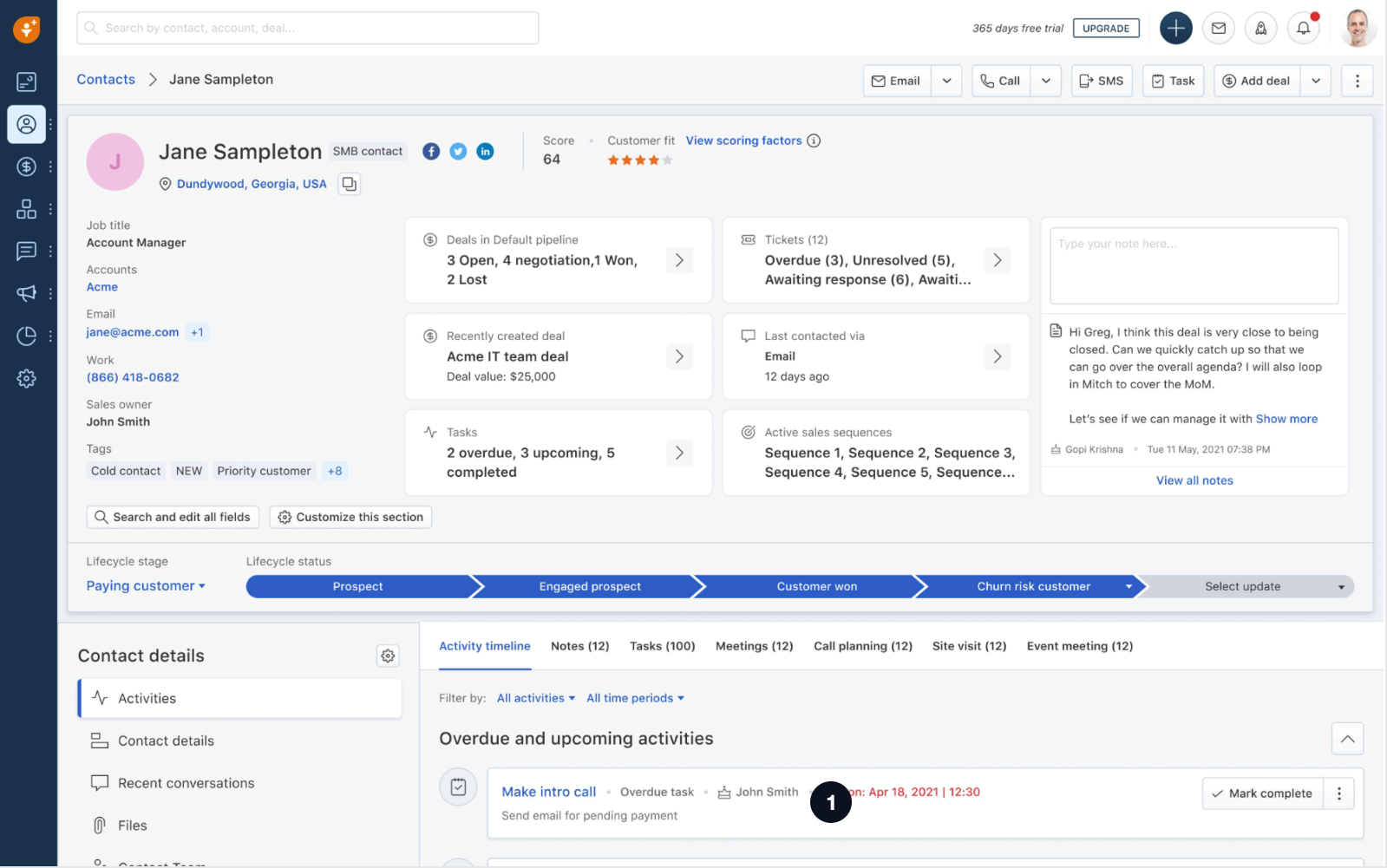
Pricing: The growth plan is the most basic plan, which costs $12.15/month, the pro will cost $34.05/ month, and the enterprise version has charges of $60.81/ month.
Wrapping up
Choosing a well-diversified, cost-effective CRM that meets business needs can propel the organization to new heights. Operational, analytical, or collaborative CRM choice depends on the company’s needs, resources, and goals. Moreover, the CRM’s efficiency depends on team acceptance; therefore, it is best to consider aspects like training and simplicity.
Pick wisely from the three CRMs shared above to prepare your business for the fast-changing digital world.








